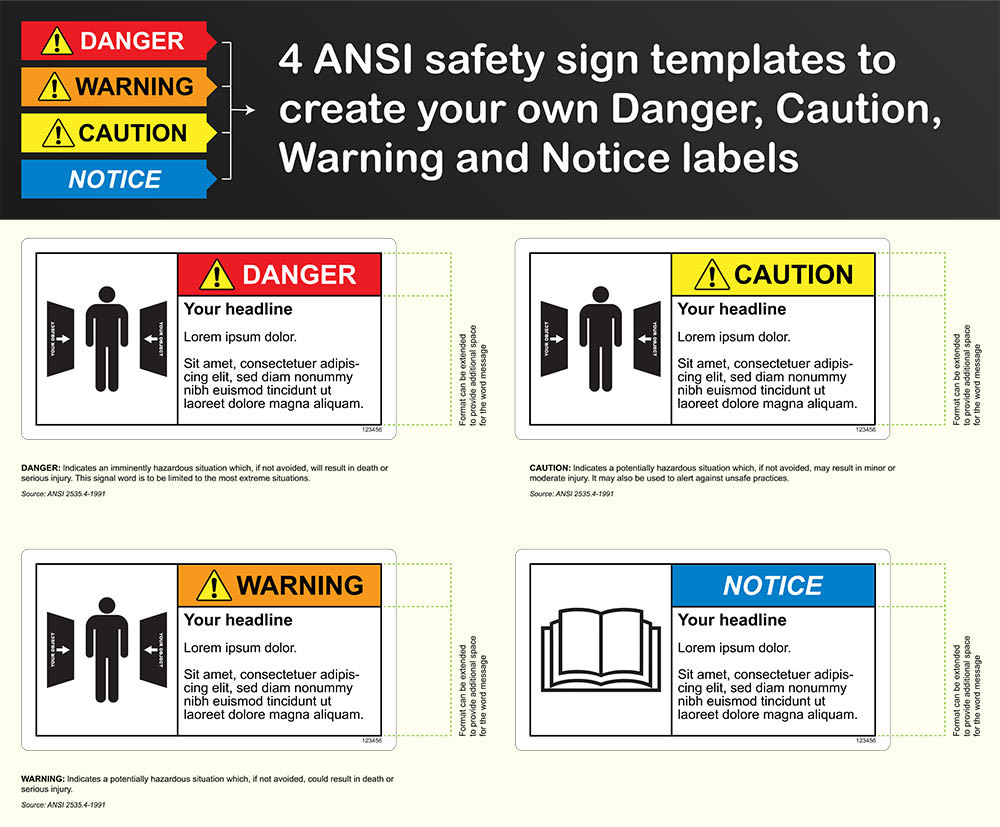
Color codes can help you quickly identify important information at a site. Red, orange and yellow mark either important dangers or safety equipment. Green marks safety information and first aid equipment. Blue indicates information not essential to safety. While these colors can have multiple meanings, they are generally grouped so you can quickly understand why something is colored as it is.
The ANSI
The ANSI is a nonprofit organization that directs and manages U.S. voluntary standards and conformity assessment systems. It works in collaboration with industry and government stakeholders to identify and develop standards with the goal of enhancing global competitiveness and quality of life in the U.S. According to ANSI, it represents the interests of more than 270,000 companies and organizations and over 30 million professionals.
One of the ways it has worked to achieve its goals is through ANSI Z535.1-2011, more easily remembered as the American National Standard for Safety Colors. This is a collection of colors with a set of intended meanings meant to be easily distinguished from one another.
ANSI is extremely specific with these colors, including descriptions of each color’s ink formulation and closest PANTONE® (a company known for a widely used proprietary system of color categorization) color. It gives the following standards for its safety colors, outlining some deviation considered acceptable:
Red: PANTONE 186 C.
Orange: PANTONE 151 C.
Yellow: PANTONE 109 C.
Green: PANTONE 335 C.
Blue: PANTONE 285 C.
Purple: PANTONE 259 C.
Those interested in this topic may also want to read our complete guide to high-visibility colors to learn more about how color can help reduce accidents and increase awareness.
Common Use Cases
ANSI’s safety colors don’t have singular meanings. Rather, each color defines a group of potential meanings, allowing a person to determine, at a glance, how noteworthy the sign or warning is and often, through context, better understand the purpose of the sign or warning.
The common use cases for these different colors are as follows:
Red
Red is a color used to signal the most important pieces of safety equipment and apparatuses in an area in addition to significant dangers. For example, red is used to mark stop buttons and switches as well as fire protection equipment. It is also placed on containers of flammable liquids and red lights are used at barricades.
Orange
Orange is generally intended to be a color of warning. It is used on signs and equipment where there is likely to be a danger. It is also used to mark energized machines and equipment, which are potential dangers.
Yellow
Yellow represents specific hazards and generally designates that one should be cautious in a given area. It marks falling, tripping and striking hazards and more.
Green
Green differs from the other safety colors mentioned thus far in that it is used to mark safety information and first aid equipment. In this way, it isn’t a color of danger or caution. It is a color that can help a person identify a helpful source of information or show where medical supplies are located.
Blue
Blue is a color intended to mark noncritical information in terms of keeping those in the vicinity safe. For example, property policies may be marked in blue. The information in question may be important, but failing to be familiar with it is unlikely to cause an immediate safety concern.
Purple
Purple is intentionally not given a defined meaning by ANSI. Instead, the intention is that the end user defines the significance of the color. This makes the color flexible while still helping draw the eye of those familiar with ANSI’s safety colors. If you are at a site using purple, find out what the color’s purpose is as defined by that site.
Conclusion
In many industries, understanding ANSI color codes should be considered essential. It helps individuals immediately recognize what to pay attention to. These colors are also a standard adopted across the U.S., it’s helpful to understand these colors in general, not just as related to your specific industry.
At Alsco Uniforms, we can help you stay in compliance with both ANSI/ISEA standards as well as OSHA standards. If you want to learn more, read about our health and safety services. We can make sure your team has flame-resistant uniforms, high-visibility clothing, first aid cabinets and other materials that meet OSHA and ANSI/ISEA standards. Reach out to us today to learn more.
References
About ANSI. American National Standards Institute Inc.
American National Standard for Safety Colors. (October 2017). American National Standards Institute Inc.
What Are ANSI Color Codes? Brimar Industries LLC.
ANSI Z535.1 — Safety Colors in Focus. (July 2023). Same Page Publishing.
